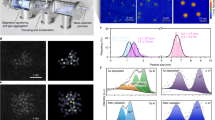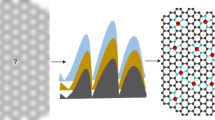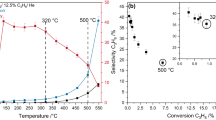Abstract
Platinum group metal (PGM)-free catalysts are promising candidates to replace PGM catalysts for the oxygen reduction reaction in fuel cells. While methodologies to determine the number of active sites are under intense development, experimentally quantifying the parameters governing the kinetics of the reaction remains rare, albeit its potential for paving the pathways for future catalysts development. The use of transient voltammetry to probe electrocatalytic reactions by varying the measurement timescales and quantifying the reaction parameters via detailed microkinetic models has shown immense success in uncovering hidden mechanistic insights, connecting theory and experiments. Here we present the application of Fourier-transformed alternating-current voltammetry for analysis of the oxygen reduction reaction electrocatalysis on a model PGM-free catalyst, iron-phthalocyanine, to decipher the kinetic and thermodynamic parameters governing the reaction. These parameters are used to shed light on the limiting steps governing the reaction and to present possible avenues to increase the performance of PGM-free catalysts.

This is a preview of subscription content, access via your institution
Access options
Access Nature and 54 other Nature Portfolio journals
Get Nature+, our best-value online-access subscription
$29.99 / 30 days
cancel any time
Subscribe to this journal
Receive 12 digital issues and online access to articles
$119.00 per year
only $9.92 per issue
Buy this article
- Purchase on Springer Link
- Instant access to full article PDF
Prices may be subject to local taxes which are calculated during checkout






Similar content being viewed by others
Data availability
All data and codes are available from the authors upon request.
Code availability
All simulations in this work were conducted using codes available for download on GitHub (https://github.com/Snitkoff-Sol/Reaction-parameters-of-ORR.git).
References
Cullen, D. A. et al. New roads and challenges for fuel cells in heavy-duty transportation. Nat. Energy 6, 462–474 (2021).
Chen, Y. et al. Enhanced oxygen reduction with single-atomic-site iron catalysts for a zinc–air battery and hydrogen–air fuel cell. Nat. Commun. 9, 1–12 (2018).
Thompson, S. T. & Papageorgopoulos, D. Platinum group metal-free catalysts boost cost competitiveness of fuel cell vehicles. Nat. Catal. 2, 558–561 (2019).
Osmieri, L. & Meyer, Q. Recent advances in integrating platinum group metal-free catalysts in proton exchange membrane fuel cells. Curr. Opin. Electrochem. 31, 100847 (2022).
Muñoz-Becerra, K., Venegas, R., Duque, L., Zagal, J. H. & Recio, F. J. Recent advances of Fe-NC pyrolyzed catalysts for the oxygen reduction reaction. Curr. Opin. Electrochem. 23, 154–161 (2020).
Kozhushner, A., Zion, N. & Elbaz, L. Methods for assessment and measurement of the active site density in platinum group metal–free oxygen reduction reaction catalysts. Curr. Opin. Electrochem. 25, 100620 (2021).
Holby, E. F., Wang, G. & Zelenay, P. Acid stability and demetalation of PGM-free ORR electrocatalyst structures from density functional theory: a model for ‘single-atom catalyst’ dissolution. ACS Catal. 10, 14527–14539 (2020).
Banham, D. et al. A review of the stability and durability of non-precious metal catalysts for the oxygen reduction reaction in proton exchange membrane fuel cells. J. Power Sources 285, 334–348 (2015).
Wang, Y., Laborda, E., Ward, K. R., Tschulik, K. & Compton, R. G. A kinetic study of oxygen reduction reaction and characterization on electrodeposited gold nanoparticles of diameter between 17 nm and 40 nm in 0.5 M sulfuric acid. Nanoscale 5, 9699–9708 (2013).
Zagal, J. H. & Koper, M. T. Reactivity descriptors for the activity of molecular MN4 catalysts for the oxygen reduction reaction. Angew. Chem. Int. Ed. 55, 14510–14521 (2016).
Thompson, S. T. et al. ElectroCat: DOE’s approach to PGM-free catalyst and electrode R&D. Solid State Ion. 319, 68–76 (2018).
Snitkoff-Sol, R. Z. et al. Quantifying the electrochemical active site density of precious metal-free catalysts in situ in fuel cells. Nat. Catal. 5, 163–170 (2022).
Anantharaj, S., Karthik, P. E. & Noda, S. The significance of properly reporting turnover frequency in electrocatalysis research. Angew. Chem. Int. Ed. 60, 23051–23067 (2021).
Govindarajan, N., Kastlunger, G., Heenen, H. H. & Chan, K. Improving the intrinsic activity of electrocatalysts for sustainable energy conversion: where are we and where can we go? Chem. Sci. 13, 14–26 (2022).
Dickens, C. F., Kirk, C. & Nørskov, J. K. Insights into the electrochemical oxygen evolution reaction with ab initio calculations and microkinetic modeling: beyond the limiting potential volcano. J. Phys. Chem. C 123, 18960–18977 (2019).
Nørskov, J. K., Studt, F., Abild-Pedersen, F. & Bligaard, T. Fundamental Concepts in Heterogeneous Catalysis (John Wiley & Sons, 2014).
Luo, M. & Koper, M. A kinetic descriptor for the electrolyte effect on the oxygen reduction kinetics on Pt (111). Nat. Catal. 5, 615–623 (2022).
Marshall, A. T. & Herritsch, A. Understanding the hydrogen and oxygen evolution reactions through microkinetic models. ECS Trans. 85, 121 (2018).
Geppert, J., Kubannek, F., Röse, P. & Krewer, U. Identifying the oxygen evolution mechanism by microkinetic modelling of cyclic voltammograms. Electrochim. Acta 380, 137902 (2021).
Haisch, T. et al. The origin of the hysteresis in cyclic voltammetric response of alkaline methanol electrooxidation. Phys. Chem. Chem. Phys. 22, 16648–16654 (2020).
Geppert, J. et al. Microkinetic analysis of the oxygen evolution performance at different stages of iridium oxide degradation. JACS 144, 13205–13217 (2022).
Zouraris, D. Electrochemical Study of Redox Enzymes and Their Utilization on Modified Electrodes. PhD thesis, DSpace (2021); https://doi.org/10.26240/heal.ntua.20463
Adamson, H., Bond, A. M. & Parkin, A. Probing biological redox chemistry with large amplitude Fourier transformed ac voltammetry. Chem. Commun. 53, 9519–9533 (2017).
Adamson, H. et al. Analysis of HypD disulfide redox chemistry via optimization of fourier transformed ac voltammetric data. Anal. Chem. 89, 1565–1573 (2017).
Adamson, H. et al. Retuning the catalytic bias and overpotential of a [NiFe]-hydrogenase via a single amino acid exchange at the electron entry/exit site. JACS 139, 10677–10686 (2017).
Bano, K., Nafady, A., Zhang, J. & Bond, A. M. Electrode kinetics associated with tetracyanoquinodimethane (TCNQ), TCNQ•–, and TCNQ2–redox chemistry in acetonitrile as determined by analysis of higher harmonic components derived from fourier transformed large amplitude ac voltammetry. J. Phys. Chem. C 115, 24153–24163 (2011).
Bond, A. M. et al. An integrated instrumental and theoretical approach to quantitative electrode kinetic studies based on large amplitude Fourier transformed a.c. voltammetry: a mini review. Electrochem. Commun. 57, 78–83 (2015).
Bonke, S. A., Bond, A. M., Spiccia, L. & Simonov, A. N. Parameterization of water electrooxidation catalyzed by metal oxides using Fourier transformed alternating current voltammetry. JACS 138, 16095–16104 (2016).
Chen, L. et al. Electrochemical reduction of CO2 with an oxide‐derived lead nano‐coralline electrode in dimcarb. ChemElectroChem 4, 1402–1410 (2017).
Gavaghan, D. J. et al. Use of Bayesian inference for parameter recovery in DC and AC voltammetry. ChemElectroChem 5, 917–935 (2018).
Gundry, L. et al. Recent advances and future perspectives for automated parameterisation, Bayesian inference and machine learning in voltammetry. Chem. Commun. 57, 1855–1870 (2021).
Gundry, L. et al. A comparison of Bayesian inference strategies for parameterisation of large amplitude AC voltammetry derived from total current and Fourier transformed versions. ChemElectroChem 8, 2238–2258 (2021).
Guo, S.-X. et al. Advanced spatiotemporal voltammetric techniques for kinetic analysis and active site determination in the electrochemical reduction of CO2. Acc. Chem. Res. 55, 241–251 (2022).
Guo, S.-X., Bond, A. M. & Zhang, J. Fourier transformed large amplitude alternating current voltammetry: principles and applications. Rev. Polarogr. 61, 21–32 (2015).
Guo, S.-X. et al. Facile electrochemical co-deposition of a graphene–cobalt nanocomposite for highly efficient water oxidation in alkaline media: direct detection of underlying electron transfer reactions under catalytic turnover conditions. Phys. Chem. Chem. Phys. 16, 19035–19045 (2014).
Kennedy, G. F., Bond, A. M. & Simonov, A. N. Modelling ac voltammetry with MECSim: facilitating simulation–experiment comparisons. Curr. Opin. Electrochem. 1, 140–147 (2017).
Lee, C.-Y. et al. Detailed electrochemical studies of the tetraruthenium polyoxometalate water oxidation catalyst in acidic media: identification of an extended oxidation series using Fourier transformed alternating current voltammetry. Inorg. Chem. 51, 11521–11532 (2012).
Lee, C.-Y. et al. Theoretical and experimental investigation of surface-confined two-center metalloproteins by large-amplitude Fourier transformed ac voltammetry. J. Electroanal. Chem. 656, 293–303 (2011).
Lertanantawong, B. et al. Study of the underlying electrochemistry of polycrystalline gold electrodes in aqueous solution and electrocatalysis by large amplitude Fourier transformed alternating current voltammetry. Langmuir 24, 2856–2868 (2008).
Liu, Y. et al. Lindqvist polyoxoniobate ion-assisted electrodeposition of cobalt and nickel water oxidation catalysts. ACS Appl. Mater. Interfaces 7, 16632–16644 (2015).
Simonov, A. N. et al. New insights into the analysis of the electrode kinetics of flavin adenine dinucleotide redox center of glucose oxidase immobilized on carbon electrodes. Langmuir 30, 3264–3273 (2014).
Friedman, A., Snitkoff-Sol, R. Z., Honig, H. C. & Elbaz, L. Simplified FTacV model to quantify the electrochemically active site density in PGM-free ORR catalysts. Electrochim. Acta 463, 142865 (2023).
Zhang, Y. et al. Direct detection of electron transfer reactions underpinning the tin-catalyzed electrochemical reduction of CO2 using Fourier-transformed ac voltammetry. ACS Catal. 7, 4846–4853 (2017).
Zhang, Y., Simonov, A. N., Zhang, J. & Bond, A. M. Fourier transformed alternating current voltammetry in electromaterials research: direct visualisation of important underlying electron transfer processes. Curr. Opin. Electrochem. 10, 72–81 (2018).
Robinson, M., Ounnunkad, K., Zhang, J., Gavaghan, D. & Bond, A. Integration of heuristic and automated parametrization of three unresolved two-electron surface-confined polyoxometalate reduction processes by AC voltammetry. ChemElectroChem 5, 3771–3785 (2018).
Zhang, X. et al. Oxomolybdate anchored on copper for electrocatalytic hydrogen production over the entire pH range. Appl. Catal. B 249, 227–234 (2019).
Pletcher, D., Tian, Z.-Q. & Williams, D. Developments in Electrochemistry: Science Inspired by Martin Fleischmann (John Wiley & Sons, 2014).
Lloyd-Laney, H. O., Robinson, M. J., Bond, A. M., Parkin, A. & Gavaghan, D. J. A spotter’s guide to dispersion in non-catalytic surface-confined voltammetry experiments. J. Electroanal. Chem. 894, 115204 (2021).
Li, J., Kennedy, G. F., Bond, A. M. & Zhang, J. Demonstration of superiority of the Marcus–Hush electrode kinetic model in the electrochemistry of dissolved decamethylferrocene at a gold-modified electrode by Fourier-transformed alternating current voltammetry. J. Phys. Chem. C 122, 9009–9014 (2018).
Li, J., Kennedy, G. F., Gundry, L., Bond, A. M. & Zhang, J. Application of Bayesian inference in Fourier-transformed alternating current voltammetry for electrode kinetic mechanism distinction. Anal. Chem. 91, 5303–5309 (2019).
Lloyd-Laney, H. et al. A multiple-technique approach to inferring bio-electrochemical reaction parameters. Preprint at ChemRxiv https://doi.org/10.26434/chemrxiv.14519709.v1 (2022).
Mashkina, E. & Bond, A. M. Implementation of a statistically supported heuristic approach to alternating current voltammetric harmonic component analysis: re-evaluation of the macrodisk glassy carbon electrode kinetics for oxidation of ferrocene in acetonitrile. Anal. Chem. 83, 1791–1799 (2011).
Honda, K., Waki, Y., Matsumoto, A., Kondo, B. & Shimai, Y. Amorphous carbon having higher catalytic activity toward oxygen reduction reaction: quinone and carboxy groups introduced onto its surface. Diam. Relat. Mater. 107, 107900 (2020).
Zagal, J., Bindra, P. & Yeager, E. A mechanistic study of O2 reduction on water soluble phthalocyanines adsorbed on graphite electrodes. J. Electrochem. Soc. 127, 1506 (1980).
Zagal, J. H. Metallophthalocyanines as catalysts in electrochemical reactions. Coord. Chem. Rev. 119, 89–136 (1992).
Zagal, J. H. & Bedioui, F. Electrochemistry of N4 Macrocyclic Metal Complexes Vol. 2 (Springer, 2016).
Venegas, R. et al. Experimental reactivity descriptors of M–N–C catalysts for the oxygen reduction reaction. Electrochim. Acta 332, 135340 (2020).
Specchia, S., Atanassov, P. & Zagal, J. H. Mapping transition metal–nitrogen–carbon catalyst performance on the critical descriptor diagram. Curr. Opin. Electrochem. 27, 100687 (2021).
Loyola, C. Z., Ureta-Zañartu, S., Zagal, J. H. & Tasca, F. Activity volcano plots for the oxygen reduction reaction using FeN4 complexes: from reported experimental data to the electrochemical meaning. Curr. Opin. Electrochem. 32, 100923 (2022).
Alsudairi, A. et al. Resolving the iron phthalocyanine redox transitions for ORR catalysis in aqueous media. J. Phys. Chem. Lett. 8, 2881–2886 (2017).
Friedman, A. et al. Application of molecular catalysts for the oxygen reduction reaction in alkaline fuel cells. ACS Appl. Mater. Interfaces 13, 58532–58538 (2021).
Ramaswamy, N. & Mukerjee, S. Fundamental mechanistic understanding of electrocatalysis of oxygen reduction on Pt and non-Pt surfaces: acid versus alkaline media. Adv. Phys. Chem. (2012).
Ramaswamy, N., Tylus, U., Jia, Q. & Mukerjee, S. Activity descriptor identification for oxygen reduction on nonprecious electrocatalysts: linking surface science to coordination chemistry. JACS 135, 15443–15449 (2013).
Zúñiga, C. et al. Elucidating the mechanism of the oxygen reduction reaction for pyrolyzed Fe-NC catalysts in basic media. Electrochem. Commun. 102, 78–82 (2019).
Rebarchik, M., Bhandari, S., Kropp, T. & Mavrikakis, M. How noninnocent spectator species improve the oxygen reduction activity of single-atom catalysts: microkinetic models from first-principles calculations. ACS Catal. 10, 9129–9135 (2020).
Zouraris, D. & Karantonis, A. Determination of kinetic and thermodynamic parameters from large amplitude Fourier transform ac voltammetry of immobilized electroactive species. J. Electroanal. Chem. 876, 114729 (2020).
Zouraris, D., Karnaouri, A., Xydou, R., Topakas, E. & Karantonis, A. Exploitation of enzymes for the production of biofuels: electrochemical determination of kinetic parameters of LPMOs. Appl. Sci. 11, 4715 (2021).
Honig, H. C. & Elbaz, L. Degradation mechanisms of platinum group metal-free oxygen reduction reaction catalyst based on iron phthalocyanine. ChemElectroChem 10, e202300042 (2023).
Kulkarni, A., Siahrostami, S., Patel, A. & Nørskov, J. K. Understanding catalytic activity trends in the oxygen reduction reaction. Chem. Rev. 118, 2302–2312 (2018).
Calle-Vallejo, F., Martínez, J., García-Lastra, J., Abad, E. & Koper, M. Oxygen reduction and evolution at single-metal active sites: comparison between functionalized graphitic materials and protoporphyrins. Surf. Sci. 607, 47–53 (2013).
Calle-Vallejo, F., Martínez, J. I. & Rossmeisl, J. Density functional studies of functionalized graphitic materials with late transition metals for oxygen reduction reactions. Phys. Chem. Chem. Phys. 13, 15639–15643 (2011).
Koper, M. T. Theory of multiple proton–electron transfer reactions and its implications for electrocatalysis. Chem. Sci. 4, 2710–2723 (2013).
Koper, M. T. Thermodynamic theory of multi-electron transfer reactions: implications for electrocatalysis. J. Electroanal. Chem. 660, 254–260 (2011).
Mukherjee, B. Solvothermally synthesized iron phthalocyanine nanostructure for high ORR response: a joint experimental investigation and DFT analysis. J. Electrochem. Soc. 167, 116501 (2020).
Resasco, J. et al. Enhancing the connection between computation and experiments in electrocatalysis. Nat. Catal. 5, 374–381 (2022).
Zhang, J. et al. Advances in thermodynamic–kinetic model for analyzing the oxygen evolution reaction. ACS Catal. 10, 8597–8610 (2020).
Tao, H. B. et al. Revealing energetics of surface oxygen redox from kinetic fingerprint in oxygen electrocatalysis. JACS 141, 13803–13811 (2019).
Hansen, H. A., Viswanathan, V. & Nørskov, J. K. Unifying kinetic and thermodynamic analysis of 2 e− and 4 e− reduction of oxygen on metal surfaces. J. Phys. Chem. C 118, 6706–6718 (2014).
Snitkoff, R. Z., Levy, N., Ozery, I., Ruthstein, S. & Elbaz, L. Imidazole decorated reduced graphene oxide: a biomimetic ligand for selective oxygen reduction electrocatalysis with metalloporphyrins. Carbon 143, 223–229 (2019).
Elbaz, L., Korin, E., Soifer, L. & Bettelheim, A. Evidence for the formation of cobalt porphyrin–quinone complexes stabilized at carbon-based surfaces toward the design of efficient non-noble-metal oxygen reduction catalysts. J. Phys. Chem. Lett. 1, 398–401 (2010).
Elbaz, L., Korin, E., Soifer, L. & Bettelheim, A. Mediation at high potentials for the reduction of oxygen to water by cobalt porphyrin–quinone systems in porous aerogel carbon electrodes. J. Electrochem. Soc. 157, B27–B31 (2010).
Acerbi, L. & Ma, W. J. Practical Bayesian optimization for model fitting with Bayesian adaptive direct search. Preprint at arXiv https://doi.org/10.48550/arXiv.1705.04405 (2017).
Acknowledgements
This work was conducted in the framework of the Israeli Fuel Cells and Hydrogen Consortium (IFCC), and the Hydrogen Technologies Center (H2Tech), part of the Israel National Institute for Sustainable Energy (NISE). It was supported by the Israel Ministry of Energy, The Israel Ministry of Science, and the Israel Science Foundation (ISF). R.Z.S.-S. thanks the Israeli Ministry of Energy for his fellowship.
Author information
Authors and Affiliations
Contributions
R.Z.S.-S. contributed to the ideation of this work, conducted most of the experiments in this work, wrote the model and simulation, analysed most of the data, and contributed to the writing of this manuscript. O.R. helped with some of the FTacV measurements, A.M.B. contributed to the analysis and provided valuable insights, and L.E. contributed to the ideation of this work, analysis and writing of this manuscript.
Corresponding author
Ethics declarations
Competing interests
The authors declare no competing interests.
Peer review
Peer review information
Nature Catalysis thanks Chang Hyuck Choi, Tatyana V. Reshetenko and Laetitia Dubau for their contribution to the peer review of this work.
Additional information
Publisher’s note Springer Nature remains neutral with regard to jurisdictional claims in published maps and institutional affiliations.
Supplementary information
Supplementary Information
Supplementary Figs. 1–10, Tables 1 and 2, methods, discussion and Notes 1–4.
Rights and permissions
Springer Nature or its licensor (e.g. a society or other partner) holds exclusive rights to this article under a publishing agreement with the author(s) or other rightsholder(s); author self-archiving of the accepted manuscript version of this article is solely governed by the terms of such publishing agreement and applicable law.
About this article
Cite this article
Snitkoff-Sol, R.Z., Rimon, O., Bond, A.M. et al. Direct measurement of the oxygen reduction reaction kinetics on iron phthalocyanine using advanced transient voltammetry. Nat Catal 7, 139–147 (2024). https://doi.org/10.1038/s41929-023-01086-0
Received:
Accepted:
Published:
Issue Date:
DOI: https://doi.org/10.1038/s41929-023-01086-0



